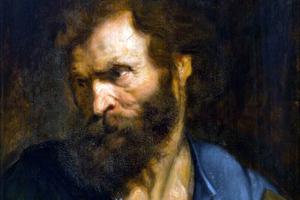What We Know About the Little-Known Sts. Simon and Jude
SAINTS & ART: We have tradition and legend associated with each of these Apostles.

As we’ve noted before, some Apostles — like Peter, James and John — get major New Testament press. Some — like Andrew — are held up for “best supporting Apostle.” Some — like Bartholomew and Matthew — are mentioned for the account of their calling. Finally some — like Simon and Jude — are named in the apostolic catalogue without anything else really said about them. Jude at least is also the name of a short epistle in the New Testament; Simon otherwise seems to disappear. We have tradition and legend associated with each.
Indeed, both Apostles have identity problems. In Biblical times, a name is a sign of one’s deepest identity, which is why names often included bar X, “son of X,” to make clear familial roots. That’s why, when Jesus acknowledges St. Peter’s confession of faith, he speaks to him by his given name, “Simon, son of Jonah” (Matthew 16:17).
In Biblical times, to change one’s name is to change one’s identity profoundly, which is why only God does it. Abram becomes Abraham, Jacob becomes Israel. And “Simon, son of Jonah,” becomes Peter, the ecclesiastical rock (Matthew 16:18).
But before Jesus names him Peter, Peter was Simon. Which is why, in order to distinguish the head of the Apostles from the “other” Simon, today’s saint often appears in the Apostolic lists as either “Simon the Zealot” (Luke 6:15) or “Simon the Canaanite” (Mark 3:18). The former, according to The Catholic Encyclopedia is not indicative of his political views (the Zealots were a party ready to use what we would today call terrorism to rid Israel of the Romans) but his zeal for God's Law. The latter suggests his origins: another Galilean.
Beyond that, the New Testament is Simon-silent. There are all sorts of traditions about where he preached, though Persia seems to be most commonplace. For much of Christian Tradition, it was said that he sawed into pieces: Christian iconography usually represents him holding a bucksaw, today usually used to cut firewood but also meat — including, apparently, human flesh.
If Simon suffers from silence, Jude suffers from confusion. St. Jude is known as the “patron of hopeless causes and things despaired of.” Devotion to St. Jude was strong in the United States, especially from the 1930s through 1970s. Many parishes included a novena to St. Jude among weekly services. The novena prayer includes the observation that “the name of the traitor has caused you to be forgotten by many,” hence, the confusion. Just as Simon is distinguished as the “Zealot” or “Canaanite” to mark him off from Peter, so Jude is distinguished from Judas Iscariot by also be referred to as “Thaddeus” (great-hearted) (Mark 3:18), the “son of James” or “son of Alpheus,” (Luke 6:16), or simply “Judas (not Iscariot),” (John 14:22). The Johannine reference is to a question Jude posed at the Last Supper, why Jesus was revealing himself to the Apostles and not the world. That question becomes an opportunity for Jesus to expand on the role of the coming to the Apostles of the Holy Spirit, the “Paraclete,” by whose power they would reveal him to the world.
Like Simon, we know little about Jude’s subsequent activities. Two matters associated with tradition have influenced his iconography. One is a tradition that says Abgar, King of Edessa in today’s Turkey, was seriously ill. He sent for Jesus to come to him, but Our Lord pressed his face to a cloth on which his image was imprinted, and sent this pre-Veronica’s Veil with Jude to Abgar, who was healed. That is why Jude is often depicted with a medallion bearing the image of Jesus either in his hand or around his neck. He is often also shown holding a halberd — a battle axe on a long pike — because that is often cited as the means of his martyrdom in Persia around AD 65. One tradition holds that Simon and Jude opposed idol worship in Persia and so were killed by the priests of the pagan cult. Because Jude is the “patron of hopeless cases,” he is often attired in green, the color of hope and life.
Our saints are illustrated in a work from the Vatican Museum that dates from the later 14th century. The center depicts a pagan altar dedicated to worship of the sun and moon. The Golden Legend says that when Simon and Jude entered that temple, they declared that the idols were full of devils, commanding the demons to come out and destroy them. We see the two black devils on the altar, smashing the idols. But we also see the temple clergy, now out of jobs in a lucrative sinecure, smashing the Apostles. Two on the left wield a halberd and a club, both about to bring them down on Jude, clad in green. Simon, in white, appears to be felled by a sword (as opposed to the saw usually associated with him). The gold background in this instance is not the typically heavenly realm we see in art of this period, but an allusion to the opulence in which the Golden Legend says the pagan temple in Suanir was outfitted.
In a world in which despair and hopelessness affect many people (consider how many people anesthetize themselves from themselves or commit suicide) the patronage of the patron of hopeless causes seems especially needed. For the St. Jude Novena Prayer and others, see here.

















